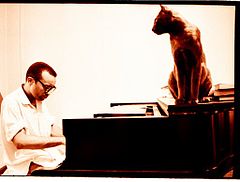Cecil Taylor
| Cecil Taylor | |
|---|---|

Taylor playing in his apartment in New York City in 1972
|
|
| Background information | |
| Birth name | Cecil Percival Taylor |
| Born | March 25, 1929 |
| Origin | New York City, U.S. |
| Genres | Jazz, avant-garde jazz, free jazz |
| Occupation(s) | Musician, bandleader, composer, poet |
| Instruments | Piano |
| Years active | 1956–present |
| Labels | Transition, Blue Note, Freedom, Hat Hut, Enja, FMP |
| Associated acts | Steve Lacy, Jimmy Lyons, Archie Shepp, Albert Ayler, Buell Neidlinger, Alan Silva, William Parker, Sunny Murray, Andrew Cyrille, Tony Oxley, Anthony Braxton, Alan Silva, Art Ensemble of Chicago, John Coltrane |
Cecil Percival Taylor (born March 15, 1929) is an American pianist and poet. Classically trained, Taylor is generally acknowledged as one of the pioneers of free jazz. His music is characterized by an extremely energetic, physical approach, producing complex improvised sounds, frequently involving tone clusters and intricate polyrhythms. His piano technique has been likened to percussion, for example described as "eighty-eight tuned drums" (referring to the number of keys on a standard piano). He has also been described as "like Art Tatum with contemporary-classical leanings".
Taylor was born in New York City. He began playing piano at age six and studied at the New York College of Music and New England Conservatory. After first steps in R&B and swing-styled small groups in the early 1950s, he formed his own band with soprano saxophonist Steve Lacy in 1956.
Taylor's first recording, Jazz Advance, featured Lacy and was released in 1956. It is described by Cook and Morton in the Penguin Guide to Jazz: "While there are still many nods to conventional post-bop form in this set, it already points to the freedoms which the pianist would later immerse himself in." Taylor's Quartet featuring Lacy also appeared at the 1957 Newport Jazz Festival. He collaborated with saxophonist John Coltrane in 1958 (Stereo Drive, currently available as Coltrane Time).
Throughout the 1950s and 1960s, Taylor's music grew more complex and moved away from existing jazz styles. Gigs were often hard to come by, and club owners found Taylor's approach to performance (long pieces) unhelpful in conducting business. Landmark recordings, like Unit Structures (1966), appeared. With 'the Unit', musicians developed often volcanic new forms of conversational interplay. In the early 1960s, an uncredited Albert Ayler worked for a time with Taylor, jamming and appearing on at least one recording, Four, unreleased until 2004.
...
Wikipedia
